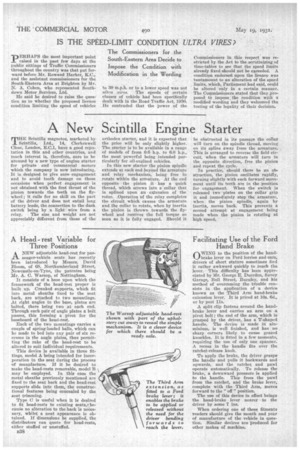A New Scintilla Engine Starter
Page 56

If you've noticed an error in this article please click here to report it so we can fix it.
MHE Scintilla magnetos, marketed by I. Scintilla, Ltd., 14, Clerkenwell Close, London, B.C.],, have a good reputation in this, and other countries, and much interest is, therefore, sure to be aroused by a new type of engine starter for private and commercial motors which the company is now introducing. It is designed to give sure engagement and to avoid tooth damage on those occasions when perfect engagement is not obtained with the first thrust of the pinion towards the teeth on the flywheel ; it Calls for no skill on the part of the driver and does not entail long battery leads, the connection to the dash switch being by a light wire from a
relay. The size and weight are not appreciably different from those of the orthodox starter, and it is expected that the price will be only slightly higher. The starter is to be available in a range of models of from 0.6 hp. to 6.0 h.p., the most powerful being intended particularly for oil-engined vehicles.
In this new starter: the pinion spindle extends at each end-beyond the armature and relay mechanism, being free to rotate within the armature. At the end opposite the pinion it has a quick thread, which screws into a 'collar that is splined upon an extension of the rotor. Operation of the relay completes the circuit which causes the armature and the collar to rotate, when by inertia the pinion is thrown towards the flywheel and receives the full torque so soon as it is fully engaged. Should it be obstructed in its passage the collar will turn on the spindle thread, moving on its spline away from the armature. . This is arranged to reverse the held circuit, when the armature will turn in the opposite direction, free the pinion and repeat the cycle.
In practice, should there be an ohstruetion, the pinion oscillates rapidly, turning slightly with each forward movement until its teeth are in the ,position for engagement. When the switch is released two plates on the .collar grip it and immediately stop the armature, when the pinion spindle, again by inertia, moves back. This prevents a second attempt at engagement being made when the pinion is rotating at high Speed.




































































































